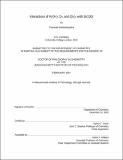Interactions of Kr(F₂), O₂, and (O₂)₂ with Si(100)
Author(s)
Sathitwitayakul, Thanasak.
Download1252627954-MIT.pdf (7.882Mb)
Other Contributors
Massachusetts Institute of Technology. Department of Chemistry.
Advisor
Sylvia T. Ceyer.
Terms of use
Metadata
Show full item recordAbstract
The high reactivity of XeF₂ with fluorinated Si is proposed to arise from localized vibrational excitation of the Si lattice as a result of the multiple collisions required to reverse the momentum of the heavier XeF₂ incident on the lighter Si lattice. This study is part of a series of experimental studies to test the hypothesis that the mass of the incident molecule is responsible for the collision induced vibrational excitation that leads to enhanced reactivity by varying the mass of the inert gas X in a X(F₂) van der Waals (vdW) molecule. The reaction probability of Kr(F₂) towards fluorinated Si(100) is measured to be 0.2±0.1, which is around two orders of magnitude higher than that of the lighter F₂ and almost one order of magnitude lower than that of the heavier XeF₂/Xe(F₂), thereby supporting the viability of the proposed mechanism. Dissociative adsorption of triplet O₂ on the singlet Si(100) surface is spin-forbidden. A possible unexplored reason for the low but non-zero reaction probability of triplet O₂ on Si(100) is an atom abstraction reaction mechanism that circumvents the spin transition since a complementary triplet O atom is released. Mass spectrometry experiments do not detect the complementary O atoms for O₂ with incident translational energy of 1-2 kcal/mol scattering from Si(100) at O coverages between zero to 1 ML at 150-1100 K, suggesting the absence of atom abstraction. Abstraction maybe undetectable due to insufficient partitioning of reaction exothermicity into translational energy of the complementary O atom. Singlet (O₂)₂ vdW dimer is more reactive than triplet O₂ at incident translational energies of about 1 kcal/mol with Si(100) at temperatures of 250-500 K. Four-center and step-wise are singlet mechanisms proposed to be responsible for increased (O₂)₂ reactivity. The probability of (O₂)₂ undergoing either or both singlet mechanisms is measured to be at least 2±1 and at most 8±4 times higher than the triplet O₂ reaction probability. This result indicates that the slow oxidation of Si(100) by triplet O₂ due to the necessary spin transition can be circumvented via oxidation by singlet (O₂)₂.
Description
Thesis: Ph. D., Massachusetts Institute of Technology, Department of Chemistry, February, 2021 Cataloged from the official PDF of thesis. "February 2021." Includes bibliographical references.
Date issued
2021Department
Massachusetts Institute of Technology. Department of ChemistryPublisher
Massachusetts Institute of Technology
Keywords
Chemistry.